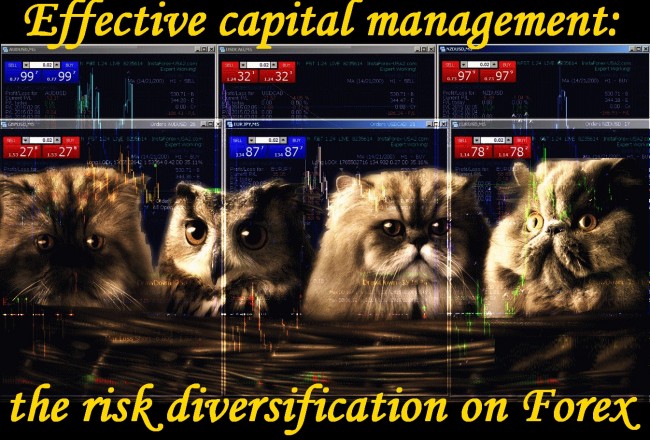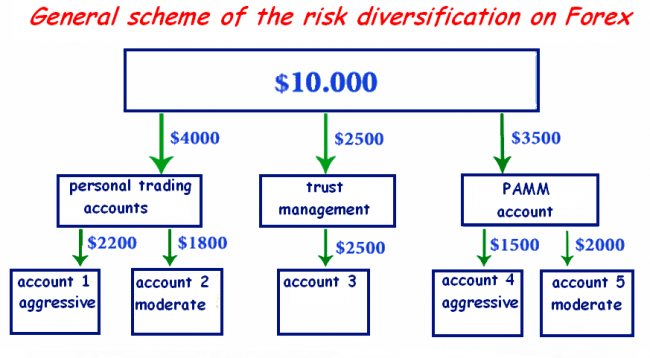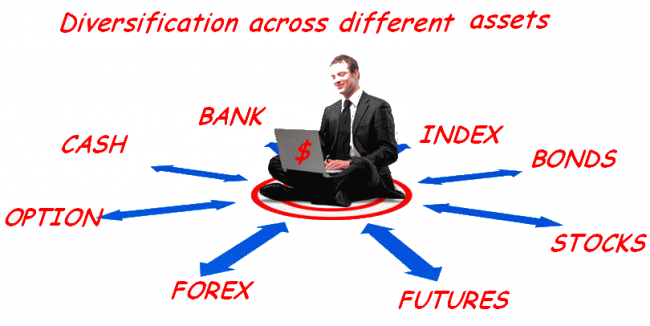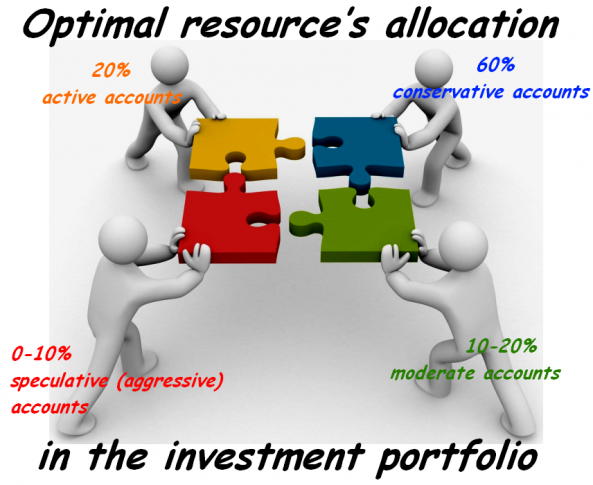Financial market has always been regarded as the one of the most risky fields of activity. Risk diversification as an integral component of any successful business enables to achieve the main goal of any investments which is to increase the probability of profit with minimal losses.
An old market saying «if you cannot avoid risk, you will diversify the one» admits that the risk is an essential condition for the profit-making. It is necessary to consider the current loss as a source of the experience and the ground for the gaining of future profit.
Diversification (from latin diversus («diverse») and facere («to make»)) from investment point of view means the creation of balanced set («portfolio») made up by various assets, where potential losses from one asset could be compensated by returns from the other ones. Literal interpretation of its meaning assumes that the work is to be done on all types of financial market.
It is more reasonable to divide money which is intended for investments on the assets having weak mutual correlation. Then the total capital will be substantially protected and even if there will be troubles to one of assets, and then other investments will probably not be mentioned. It is also diversification of risks which by right is considered the important tool at management of the capital.
Reasonable risk management enables investors to give up a part of potential profit in portfolio in order to save the larger part of the capital. Risk diversification process on Forex can be provisionally divided into minimizing of trader’s risk and the one of the investor. While it seems that both processes are united with mutual aim, there are however different paths to reach this aim.
Main objectives and types of the diversification
The diversification as one of the policies of capital management possesses an essential shortcoming: the risk reduction leads to the decline in potential profits. The objectives of such policies are:
- Optimal risk allocation;
- Steady (average) profitability of all the investments;
- Protection of investment capital.
Any investment portfolio may be split into two parts: the aggressive assets with high risks and high profitability and conservative assets with low risks and low profit expectancy. An example is set out below:
It is vital to strive to invest in a way that any chosen option would be at least cost-efficient. Traditionally there are two risk groups of acting on financial market:
Trade risks comprise the risks which arise or may arise out of trading activity and cause losses a result of unprofitable deals. Usually there can be highlighted the risks, related to psychological condition, the risk of losing control over the deals (see below – «Non-trading risks») and the risk of non-compliance with the trading system’s rules.
Remedy: control over personal emotions; professional attitude to trading, to the choice of assets, means and methods.
Non-trading risks are the risks which are not associated directly with the trader (or investor): problems with the brokerage company (technical, legal, financial), technical problems with the equipment and telecommunications systems. Sometimes risks related to bad faith of the manager are also essential.
Remedy: thorough selection of the certified broker, of the quality equipment and business partners.
Diversification on trading assets
The most risky and highly profitable sector of the Forex market is a marginal trade with leverage. Borrowing mechanisms with minimal collateral requirements enable investors to earn and lose money at the same pace.
Optimal asset allocation depends on steady asset returns predictability. The intermarket risk diversification ensures that the profit can be made at the time when the main market calms down while the secondary market becomes active. The risk is minimized by the trading several assets simultaneously. If one asset causes losses, the former can be compensated by the profit from the other instruments.
The main requirement for the successful diversification is the absence of mutual correlation between assets’ returns. The assets do not have to be connected with each other by any fundamental or technical factors.
For example, if someone buys EUR/USD futures contract and enters into EUR/USD spot transaction, as a consequence the investor will have relatively the same assets with equal dynamics and risks, so that the risks will not be insured.
An example from trader’s experience: In the middle of 2014 a trader opened the large trading account exclusively for the oil futures trading. Steady decline in oil prices led to the fact that from 01/06/2014 to 01/01/2015 average monthly percentage of profit from trading amounted to 43 per cent (!).
In the beginning of 2015 the correction (which was highly predictable) had started. However, it was difficult to «catch the wave», the trader was nervous and ceased to «feel» the market that led to losses. Fortunately, there was one more trading account for EUR/USD, AUD/USD, USD/JPY traded pair which was strengthened by the investments at the time when problems with the main (oil) account occurred. Monthly trade profitability had made up approximately 27 per cent that enabled the trader to recover all losses suffered, to act in the market constantly and to participate actively in the new wave of oil trading within 8 months.
The result of the risk diversification across financial assets is the protection of the capital by steady profitability and mutual independency of its components.
Diversification upon trading strategies
The absence of the ideal market means that there is no ideal model of the trader’s behaviour. Every trader feels the need a diversified set of trading strategies with the high short-term and long-term profitability. The optimal option is to apply various strategies to distinct trading accounts and relocate investments to the most successful ones.
The trading strategies are assumed to have three types. As there are no clear limitations between the types, the system is treated as:
- conservative, if the maximum drawdown is not more than 20% (±3%) and margin level is not more than 10% reliable but low profitability, not more than 3-4% per month;
- aggressive, if the maximum drawdown is higher than 40%, margin level is more than 25% investor should be aware that his positions may be closed out, but if succeeds in trading, then the high risk will be compensated by a high profitability – more than 40% per month.
- moderate there are various transitional options:
- drawdown 25%-40%, margin level from 10% to 25% reasonable proportion of risk/profitability;
- drawdown 40%-60%, margin level 10%-25% active conservator;
- drawdown 25%-40% and margin level is not more than 25% rational scalping.
Sometimes trade on the basis of the same strategy, but using various assets, timeframes, deposits, brokers applies as a means of the risk diversification. The strategies of the same type towards any assets will show at the same time comparatively equal results (gains/losses). To that end, it is recommended that strategies with different level of aggression should be included in the investment portfolio. If several systems based on the different logical principles apply, then the diversification of capital using such systems provides an essential risk reduction.
As a result of the diversification there must be maximum effect from the all trading strategies applied by the trader.
Diversification depending on the characteristics of trading strategies
As a rule, it is enough to determine the set of characteristics and the asset, trading which makes a high profit, and to trade further using this method. However, there are some situations where using the same strategy with various characteristics (for example, various periods) provides a more steady effect. Capital allocation among mentioned alternatives suggests that it will provide the effect which amounts to the effect that can be obtained as a result of the strategy with the medium efficiency.
You remember: diversification of risks is the main way to squeeze out an efficiency maximum of the trade strategy which are available in your arsenal of the trader.
If the strategy fits the current situation in the market, then the diversification may significantly increase the assets’ returns without the risks which may be borne as a result of unfavourable market conditions.
Diversification among multiple markets
Don't limit yourself in the choice of trade assets - use trade tools of various financial markets. Contemporary technologies enable even small investor to trade on various trading platforms: currency exchange, stock exchange and commodities markets. The main advantage of the asset’s allocation among these markets are, as a rule, that the various markets dependent weakly on the others, and therefore the losses will be recovered by the profit from the other markets.
Risk diversification among brokers
Several brokers may be involved in the trade of assets of various types and on the multiple trading platforms if it provides profit. Every broker shall meet the high requirements to the technical, financial and legal support of the services. In order to avoid the possibility of broker’s bankruptcy the investor should not deal with affiliated companies. Investments may be allocated proportionally between domestic and EU brokers. Investor who works with American brokers must be aware that there is a severe control over the trade transactions from the competent authorities.
Trust as a type of risk diversification
Although the trader can have solid experience, there can be situations where he can still suffer losses. Therefore, the assets may be transferred to a trustee in trust so that a qualified person will deal with your investments. The assets may be allocated among different trustees using various strategies in a way that investments will no longer depend on the one trader so that drawdown will not amount to essential losses.
PAMM accounts as a type of portfolio diversification
Investing in PAMM and LAMM accounts is a less risky business than that of the direct trade because the investor can choose the steadiest and the most reliable project. All the amount of investments is not recommended to allocate using only one of the possible methods, even though it shows great result and growing trade profitability line at the moment. Every trade account is dealt with by a particular trader whose mistake may lead to the loss of the investment. Investing simultaneously in several PAMM accounts with relatively equal outcomes but diverse internal characteristics (profitability, aggressiveness, strategy, manager’s remuneration) enable investor to eliminate almost all the risks due to minimizing of losses and income averaging.
Let us assume that you have looked through the rankings carefully and your attention has been drawn by three PAMM accounts with monthly returns: 3% (max/min 5%–1%), 4% (6%–2%) and 5% (8%–2%). There are average limits of 6.33% – 1.67% and average percentage of the accounts – 4.67%. These figures indicate the amount of possible returns.
When choosing a PAMM account, please focus on:
- the personal capital of the manager – if he holds relatively large amount of his own money on general account and constantly increases it, then he is assumed to trade carefully and in a reasonable manner.
- the quantity and shares of investors – the project is more reliable if there are several large investors rather than a plenty of small «anxious» ones, each investing $20.
An example from the trader’s experience: there is no doubt that obtaining the insider’s information constitutes the strong trader’s argument. There exist PAMM accounts which are designed for several large investors who have permanent access to the data – analytics of large banks, investment funds, and information agencies. Such investors can prescribe the trader to use the special tactics of the trade due to which the investors will get a high return. Mostly entry threshold for such projects is rather high but if you joined the project successfully as an investor, be sure to save it in your investments portfolio.
Overall outcome represents the sum of all the outcomes from each investment object. See below an example of the capital allocation among various objects for beginner investor with minimal experience:
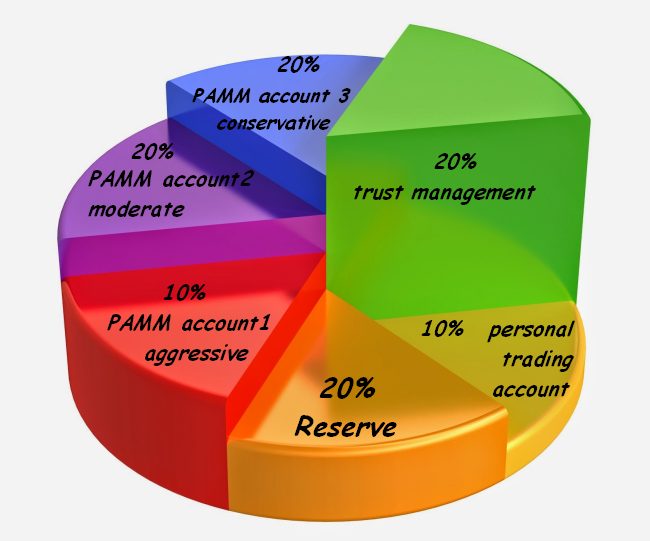
Conclusion
Successful investors’ experience shows that the steadiest outcomes may be achieved if there is the following resource’s allocation in investments portfolio:
Identify which aim is more important for you. What do you want your money to achieve? Would you like:
- … to earn money and are ready to take a risk? Invest large amount of money in aggressive strategies and assets.
- … to get a return, and save investments? Invest in conservative assets - steadiness will help you to recover possible losses.
- … to learn and attempt to do something new without essential losses? Open a cent account and make experiments.
Always keep in memory that the main purpose of the trade is making the constant steady profit. Form your own attitude to the risk, create your own formula of the risk allocation, and you will always be a winner.
Social button for Joomla



